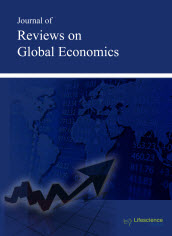jrge
Abstract - A Theory of Quantitative Easing Policy and Negative Interest Policy Based on the Japanese Experience
|
|
Abstract: Using a two-period overlapping-generations model, I elucidate how quantitative easing policy and negative interest policy affect an economy based on the Japanese experience under the Abe cabinet. Quantitative easing policy forces a huge amount of money hoarding. Accordingly, the rate of return for money is required to rise. This implies that disinflation and/or deflation are accelerated in Japan, which is in line with reality. On the other hand, quantitative easing policy stimulates the aggregate demand, which brings about a mild recovery in business. The business upturn tightens the foreign market because of an increase in imports and causes the home currency to depreciate. Negative interest policy implies there is a tax levied on money hoarding. Hence, as longas the government expenditure is kept constant, money circulating in an economy decreases, thereby discouraging business. Such a downturn reduces aggregate income and imports. This induces excess supply of foreign exchange. Consequently, the exchange rate appreciates to equilibrate the market. These characteristics of the business cycle in conjunction with changes in the attitude of the monetary authority are entirely consistent with the current Japanese experience under Abenomics. Keywords: Quantitative easing monetary policy, negative interest policy, Abenomics.Download Full Article |
Abstract - A Note on Intrinsic Inflation Persistence and the Optimal Inflation Rate
|
|
Abstract: This paper examines the implications of intrinsic inflation persistence, namely inertia that inflation inherits from its own past, on the conduct of optimal monetary policy. We study the optimal long-run rate of inflation in a basic New Keynesian model, which is augmented for intrinsic inflation persistence. We show that the commitment solution for the monetary authority leads to steady-state outcomes in which inflation is positive. Keywords: Optimal monetary policy, Phillips curve, inflation persistence.Download Full Article |
Abstract: Global Financial Crisis of 2008, Asymmetric Effects of Exchange Rate Changes, and Stability of the Demand for Money in Japan
|
|
Abstract: We wonder if Global Financial Crisis of 2008 affected stability of the demand for money in Japan. In testing this hypothesis we deviate from previous studies which either excluded the exchange rate from money demand function in Japan or have not been able to find any significant relation between the exchange rate and the demand for money. While we address stability of the demand for money, we show that failure to find a cointegrating relation or significant effects could be due to assuming a linear model in which exchange rate changes have symmetric effects. Once we consider a nonlinear ARDL approach of Shin et al.’s (2014), we show that not only variables in the money demand are cointegrated but exchange rate changes have asymmetric effects. In the long run, while appreciation of yen has significantly positive effect on the demand for money in Japan, depreciation does not. We also find a stable money demand which was not affected by 2008 financial crisis. Keywords: Nonlinear ARDL Approach, Symmetry versus Asymmetry, Money Demand, Japan.Download Full Article |
Abstract: How the Quantitative Easing Affect the Spillover Effects between the Metal Market and United States Dollar Index?
|
|
Abstract: This study explores both return and volatility spillover effects, the co-integration relation and the correlative relationship between the metal market in London metal exchange and United States exchange rate market, and the risk premium and leverage effect in each of these two markets for the periods before and during quantitative easing (QE). Empirical results show that, as the QE is executed the risk premium in US exchange rate market will disappear; and the speed and direction of the adjustment back to equilibrium respectively becomes greater and is reversed for the co-integration relation in metal market. Regarding these two markets only the return spillover effect is affected, and the degree of negative correlative relationship becomes more obvious as the QE is executed. Keywords: Spillover effect, United States dollar index, Metal market, Quantitative easing.Download Full Article |
Abstract: Fairness and Ethics in Spending
|
|
Abstract: Islamic faith and the ethical dimensions of the individual and the community have a significant role in guiding economic behavior by connecting the worldly life to the hereafter. In the Islamic economics paradigm, by relating ethics to the economic behavior of spending, we exhibit the good (bad) attributes of ethical (unethical) behavior. In this paper, we contribute to developing a measure of the overspending and underspending that allows testing the presence of wastefulness and niggardliness. Keywords: Consumer behavior, Spending, Ethical utility, Earning layer, Belief holding, Threshold spending, Islamic economics.Download Full Article |



